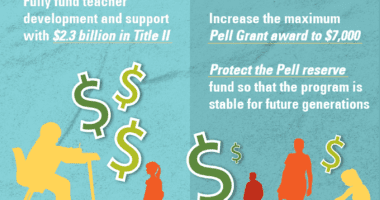Common Core: Making Progress for All Students
This post initially appeared at the National Center for Learning Disabilities.
I have spent more than a decade in public education, working to make sure that all children succeed. As a former school and district leader, I have heard too many accounts of young people who progress through school believing that they are receiving an education that will prepare them to pursue their dreams, only to find out how woefully short their true course of study has left them. And there are others who know the work they are currently focused on is not rigorous enough to accomplish their professional and personal goals. In both instances, the standards guiding these students and their teachers’ efforts did not represent true preparation for success in college, career, and life.
There is no single initiative or practice that will magically enable our nation to ensure that all young people achieve at high levels and are equipped for creative and productive lives. There are, however, key elements that are essential to moving forward toward this goal. While the Common Core State Standards (CCSS) alone cannot transform the outcomes of U.S. education, they do serve as a guidepost for where we should be targeting our efforts at college and career readiness.
The CCSS are comprised of rigorous academic standards that can, when implemented with ample supports, get all students college- and career-ready and help close persistent achievement gaps. These standards were designed to prepare students not only for today’s careers, but for those in the future. Content experts across K-12, business, and education wrote the standards and, to date, 45 states and the District of Columbia have adopted them in both literacy and math.
While these standards represent what today’s students need to know to be successful in postsecondary study, they also represent a serious stretch for students and schools in every state. They require that school district leaders, administrators, and teachers work together more effectively to reach these higher levels of achievement. If implemented thoughtfully, they have the potential to dramatically raise the rigor of instruction — and the level of achievement — in schools across the country.
This is not easy work: To close achievement gaps, many students — English-language learners, students with learning disabilities and students struggling academically — will require targeted supports to ensure their success. But the goals of raising achievement, closing gaps, and preparing all students for the demands of college and career are achievable. And we all must be held accountable for making meaningful progress.
Today’s conversations about the new standards remind me of discussions that occurred when No Child Left Behind (NCLB) was first implemented. Prior to its passage in 2001, states, districts, schools, and educators weren’t held accountable in a meaningful way. Schools were not required to assess their students with any continuity, and there were no consequences for lack of progress or improvement. Most detrimental was that these pre-NCLB school report cards masked results of students by not looking at groups individually. If you can’t see the problem, how can you fix it?
Many people fought it, but the introduction of NCLB paved the way for real results for student progress. The law required that states and districts look at the progress of different groups of students in order to focus on the particular needs of students — and it gave us a glimpse at how students with disabilities, English-language learners, students of color, and low-income students were faring. Once we were able to see, indisputably, how each set of students was doing, we could set out to address the challenges.
The most recent long-term trend data from the National Assessment of Educational Progress — the only assessment of how student progress across the nation has changed over the last four decades — show that students in all groups have improved over that time period. Much progress has been made since NCLB, but we’ve reached a plateau. Now is the time to double our efforts and press ahead to ensure that our students — all of them — are learning what it takes to succeed.
Now, the CCSS will give us an opportunity to more closely align what students are learning with the knowledge and skills they need for the real world. And the tests that go along with these standards will play an equally important role — they will allow us to continue to understand how our students are doing in the classroom. Each and every one of our students deserves a high-quality education.












